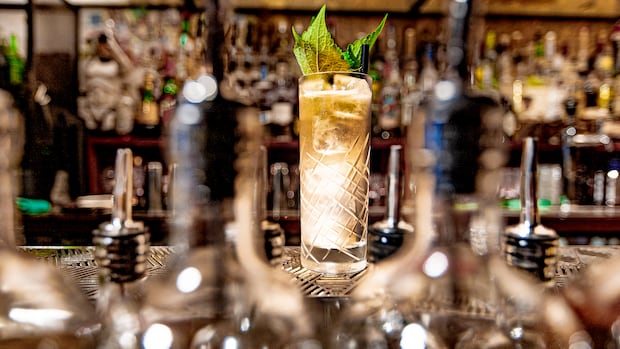Cost of Living6:06Why do non-alcoholic drinks cost nearly as much as the real thing?
On a Friday night in Ottawa’s Hintonburg neighbourhood, Sophia Marco scans the drink menu at her local bar.
Around her, friends laugh over cocktails and beer, but she’s eyeing the mocktail section — where prices hover around $14 or $15 a glass.
Marco stopped drinking alcohol in 2020. She didn’t like how it made her feel but still enjoys a night out and a well-made drink.
Since she switched to non-alcoholic options, what surprises her most is that mocktails “tend to be around the same price as the cocktails.”
What to know about Toronto’s growing non-alcoholic beverage scene
More Canadians have been seeking non-alcoholic beverage options and Toronto businesses have been finding more ways to cater to the growing community in the city. Sarah Kate, founding editor of non-alcoholic lifestyle magazine SomeGoodCleanFun, explains to CBC’s Madi Wong why the demand for non-alcoholic beverage options and events is higher than ever.
Across Canada, the non-alcoholic drink market is booming as more people look for ways to socialize without the buzz. But alcohol-free doesn’t necessarily mean cheaper.
“When I first started to order mocktails or non-alcoholic drinks, I was shocked at first,” says Luba Khalil. “I thought alcohol was the expensive part. But now I’m just kind of like, whatever — everything’s expensive these days.”
All process, no proof
Making non-alcoholic drinks isn’t necessarily simpler or cheaper than producing traditional ones.
Mathieu Gagnon, co-founder of Sober Carpenter, a Montreal-based brewery specializing in non-alcoholic beer, says the process is much more technical than one may think.
“We actually use the same ingredients that go into beer,” he says. “We just stop the fermentation before it reaches above 0.5 per cent.”

The method, called arrested fermentation, cools the beer to near-freezing to stop fermentation — a process Gagnon says requires precision to preserve flavour and aroma. That’s the costly part, not the alcohol, he says.
While Sober Carpenter’s beers are labelled non-alcoholic, they contain less than 0.5 per cent alcohol — a trace amount that meets Canadian labelling standards.
Crafting a good zero-proof or low-proof cocktail or spirit can be even more involved.
Rudy Aldana, co-founder of Parch, a non-alcoholic, agave-based cocktail brand, says removing alcohol means producers have to build flavour complexity from scratch.
“Alcohol is a very cheap ingredient,” he says. “It helps with preservation. It also delivers flavour. So when you remove it, you have to replace it with other ingredients that bring that same level of complexity.”
He says Parch uses botanicals and natural extracts to replicate the taste and texture of traditional cocktails — all of which add to production costs.
“Alcohol might be 10 to 20 per cent of the cost of an alcoholic drink,” he says. “So when we build something from scratch, it can easily double that.”
Scale also plays a role. Gagnon says smaller breweries like his operate on limited production runs compared with major beer makers.
“When you’re making traditional beer, you might be running 250,000 cans in a batch,” he says. “We’re doing smaller runs because the demand isn’t there yet, and that pushes the cost per unit up.”
Perception has a price
Production costs aside, perception also plays a powerful role in keeping prices up.

David Soberman, a marketing professor at the University of Toronto’s Rotman School of Management, says part of the reason non-alcoholic drinks cost as much as their boozy counterparts is psychological.
“If you want something to be perceived as a substitute, then you need the price to be quite similar,” he says. “It could be perceived as being lower quality and not very good if it was like one third the price.”
Jordan LeBel, who teaches marketing at Concordia University’s John Molson School of Business, says marketing and packaging also play a major role in shaping how consumers perceive value.
“The costs are still fairly high,” he says. “You’ve got to pay for the ingredients, the bottles, the shipping, the access to shelves.”
He adds that as the category grows, brands also need to compete for attention.

“If you want to get consumers’ attention then you need to invest in marketing, advertising, maybe hire a famous spokesperson or whatnot,” he says. “Which explains why you end up with a market price that’s on par or maybe slightly below sometimes, the alcoholic options.”
The future on tap
As the category grows, both experts say prices could eventually come down — but not dramatically.
“Typically, as an industry ages, you see more consolidation — players buying each other out, getting those economies of scale,” says LeBel. “You might see fewer options on the shelves, because we may discontinue some, prune the portfolio or let go of brands that aren’t selling well.”
Soberman says that competition may eventually bring some price relief, but that zero-proof beverages will likely remain premium products, with prices to match.
“I’m not sure the objective is to compete versus the alcohol versions based on price,” he says. “When you do that, it’s hard to stay profitable. So it’s probably a better strategy to sort of compete on taste.”
While the prices may not be ideal, Khalil says opting for a mocktail is about more than just cost — it’s about the experience and being part of the moment in social settings.
“I don’t drink, but I have a lot of friends who like to drink, and I don’t want to be left out,” she says. “Sometimes it’s nice to treat yourself. Sometimes you just want something nice and fancy.”



